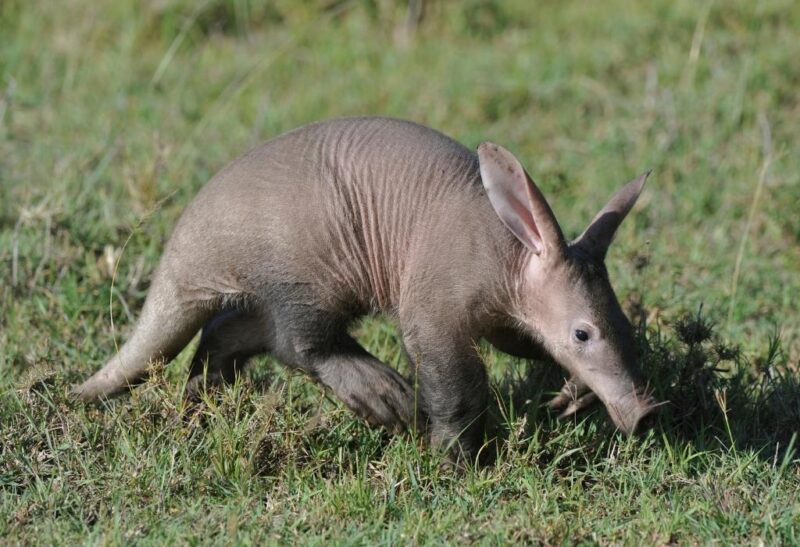Animal body parts that are enlarged or elongated always bring about fascination and genuine interest from any observers. In particular, big noses could easily catch anyone’s attention because they are prominently situated on the animal’s face.
Animals with big noses are:
1. Long-beaked Echidna
2. Black Rhinoceros
3. South American Coati
4. Bushpig
5. Elephant Seal
6. Pinocchio Frog
7. Longnose Gar
8. Sawfish
9. Mandrill
10. Domestic Pig
11. Tapir
12. Long-nosed Bandicoot
13. Aardvark
14. Proboscis Monkey
15. Elephants
If you want to know more about why these animals have big noses, their physical attributes, diet preferences, habitats, distinctive characteristics, and other interesting information, read further this article!
Table of Contents
Do All Animals Have Noses?
Not all animals have noses. These animals, such as butterflies and octopuses, instead sense the world around them using specialized body parts such as antennae, in the case of butterflies, and arms, in the case of octopuses.
Similarly, not all animals that have noses can smell, such as lizards and snakes. Instead, they use their tongues to collect odors from the air. Their noses are used for prey detection.
What Is an Animal’s Nose Called?
Vertebrate noses are called a proboscis, particularly when they are elongated. It is entirely different from a snout, which refers to the protruding part of an animal’s face that contains the mouth, nose, and jaw. Rostrum, on the other hand, refers to a snout-like projection that consists of the nasal cavity, teeth, and palate.
15 Animals With Big Noses
1. Long-beaked Echidna
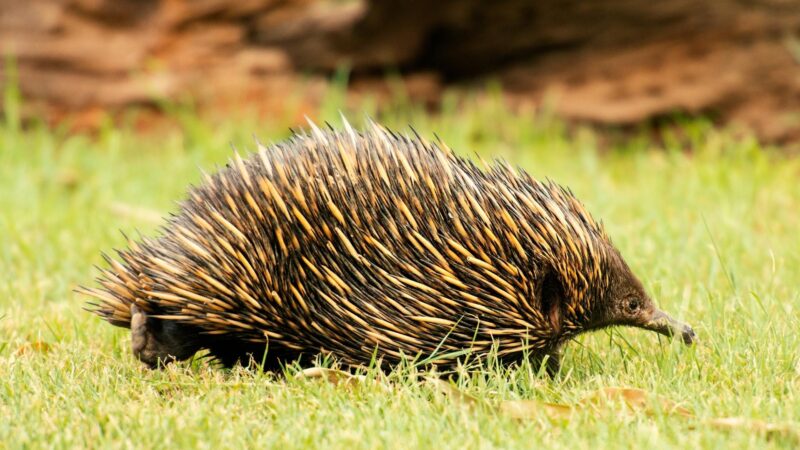
Long-beaked echidnas have elongated snouts that they use, together with their forelimbs, for foraging and digging into the ground for earthworms. This method is called a head press, and it’s a probing technique in which they increase the pressure into wet soil to make a depression, then obtain food. They also have specialized tongues that have sharp, spiky teeth-like structures used to grab onto food, as well as for eating.
- Scientific Name: Zaglossus
- Appearance: Prominent down-curved snout, toothless but with spiky teeth-like projections on their tongues, clawed feet, and long, dense fur.
- Color: Depending on the species, they can be brown on their core body, as is the case for Eastern and Western long-beaked Echidnas, while Sir David’s long-beaked echidna is raw umber brown in coloration. All three species have white spines.
- Lifespan: Up to 30 years (captivity)
- Habitat: Mountain forests and summits, as well as in alpine meadows and grasslands.
- Height: 30 to 55.6 centimeters
- Weight: 2 to 16.5 kilograms
- Diet: Earthworms, termites, ants, and other insects. They occasionally feed on grubs.
- Place Of Origin: New Guinea
- Characteristics: Long-beaked echidnas are notoriously elusive and exceedingly reclusive. They are perceived as solitary beings.
2. Black Rhinoceros
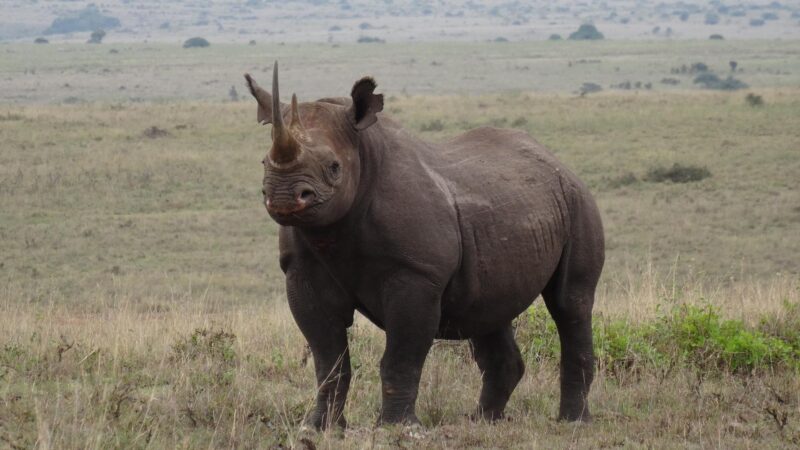
According to the IUCN, black rhinos are considered critically endangered due to poaching and illegal trade between Asian consumers who use their horns for folk medicine.
Adults usually defecate on dung piles as a form of communication saying that a certain location was recently visited. Females are rarely aggressive with each other, but males or a male and females will fight for dominance.
- Scientific Name: Diceros bicornis
- Appearance: Heavy and stocky-bodied with a large head, broad chest, short neck, small and tufted tail, large teeth, and nearly hairless skin with folds.
- Color: Generally, they are gray in coloration but can be varying shades of brown depending on the soil conditions of their habitats.
- Lifespan: Up to 35 years (wild), up to 45 years (captivity)
- Habitat: Deserts, forests, and grasslands that are tropical and subtropical.
- Height: 1.4 to 1.8 meters
- Weight: 700 to 1,400 kilograms
- Diet: Small trees, twigs, legumes, woody shrubs, and grass. They preferably consume Acacia species and plants in the Euphorbiaceae family.
- Place Of Origin: Africa
- Characteristics: Males are solitary except during the mating season, while females stay with their young offspring. They are sedentary, territorial, and less active during midday.
3. South American Coati
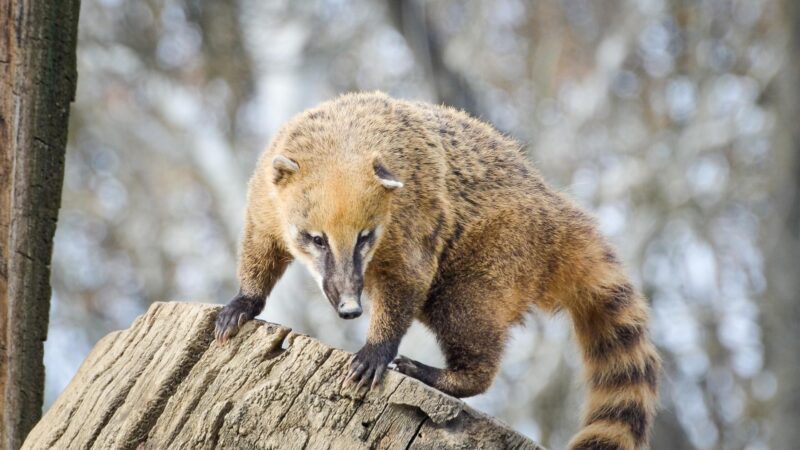
South American coati has flexible, elongated noses that allow them to forage for food even in overturned debris and under-leaf litter. They also have strong forelimbs and claws that allow them to climb trees and dig around for food found under rotted logs. Interestingly, they can reverse the joints of their ankle bones, which allows them to descend trees with their head first.
- Scientific Name: Nasua nasua
- Appearance: Narrow head, slightly upturned and elongated nose, small eyes and ears, long tail, and thick fur.
- Color: Upperparts range from gray to dark brown to a dark or light rust coloration. It has a brown muzzle with pale spots found below, above, and behind the eyes, as well as white-fringed eyes and black tails with yellow rings.
- Lifespan: Up to 8 years (wild), up to 17 years (captivity)
- Habitat: Forested habitats such as evergreen, deciduous, cloud, and riverine gallery forests
- Height: 73 to 136 centimeters
- Weight: 3 to 6 kilograms
- Diet: Fruits, palms, larval beetles, eggs, centipedes, spiders, scorpions, ants, small mammals such as rodents, and even carrion when it is available. They occasionally feed on chicken.
- Place Of Origin: Central and South America and Mexico
- Characteristics: Predominantly diurnal, but males can be seen exhibiting nocturnal activity. Males are solitary, while females form bands of up to 30 individuals together with their young. They are mostly terrestrial but also display arboreal activities, specifically when mating, sleeping, and giving birth.
4. Bushpig
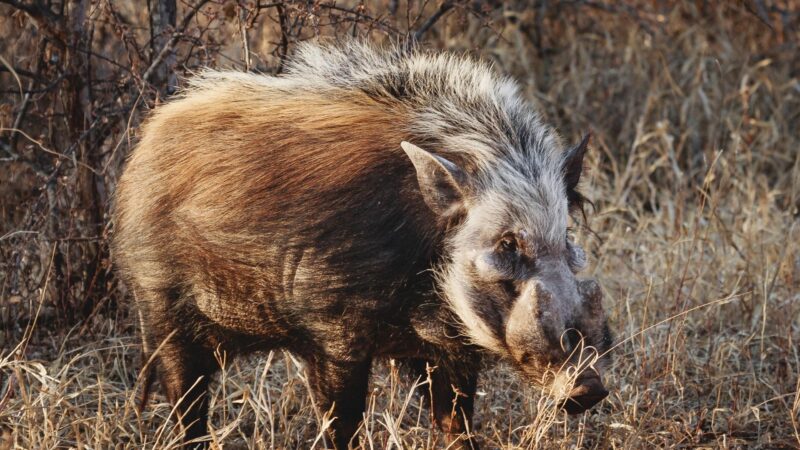
Bushpigs are strong hogs with elongated, muscular snouts they use to consume food. They have experienced an increase in their numbers in recent years as the population of leopards, their main natural predator, has faced a decline. When fighting with other individuals, bushpigs aggressively wag their tails, paw or roll over the ground, and raise their hairs.
- Scientific Name: Potamochoerus larvatus
- Appearance: Shaggy, round-bodied pig with blunt snouts, small legs, pointed and moderately tasseled ears, buckled toes, small eyes, long and tufted tails, small upper tusks, prominent lower tusks, and a mane forming from between its ears to its spine and extending up until its rear.
- Color: The coat ranges from light reddish brown to grayish brown to nearly black in coloration. Usually, they have a black head, then the rest of the body is of a different shade.
- Lifespan: Up to 20 years (wild)
- Habitat: Riverine vegetation, woodlands, forests, reed beds, forests (montane, gallery, and flooded), and swamplands.
- Height: 100 to 150 centimeters
- Weight: 54 to 115 kilograms
- Diet: Plant roots, fruits, rhizomes, tubers, bulbs, and insect larvae. They also feed on a variety of small vertebrates, invertebrates, and carrion.
- Place Of Origin: East and Southern Africa
- Characteristics: Mainly nocturnal but can be diurnal during colder months, sedentary, highly territorial, and social as they can be found in groups called sounders that are made of up to 12 members.
5. Elephant Seal
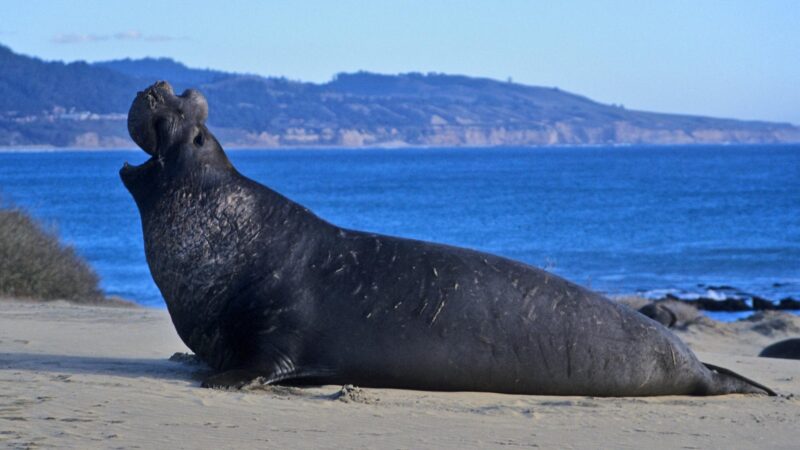
Elephant seals, specifically adult males, are usually aggressive with each other except when just coming out of molting. When fighting, they aim for the proboscis of their opponents and then pin them on the ground. They, however, don’t develop their large inflatable proboscis until they reach puberty at approximately 7 years old.
- Scientific Name: Mirounga
- Appearance: Large, torpedo-bodied seals. Males have inflated proboscis and thick necks that are usually adorned with scars due to fighting. Females have smaller noses and retain their smooth necks. Both have two-lobed hind flippers and two wide rear flippers.
- Color: Northern elephant seals are grayish-brown or yellowish in coloration, while Southern elephant seals are bluish-gray.
- Lifespan: Up to 15 years (captivity), up to years (wild)
- Habitat: On the rocky, sandy, or muddy shores of coastlines found on offshore islands.
- Height: 2 to 6 meters
- Weight: 400 to 3,700 kilograms
- Diet: Predominantly squids such as the smooth-hooked squid and the glacial squid, as well as a variety of fish. Northern elephant seals like to eat skates, rays, and sharks.
- Place Of Origin: Pacific Ocean (Northern elephant seals), subantarctic islands in the Southern hemisphere (Southern elephant seals)
- Characteristics: Solitary when in water but relatively social on land as they gather in large groups. They are migratory, territorial, and are considered nocturnal hunters.
6. Pinocchio Frog
While little is known about the Pinocchio frog, scientists propose two theories on why these tree frogs have relatively longer noses compared to other frogs.
The first is that it is used for mating purposes, as it potentially attracts females, and the second is so that frogs can distinguish one species from another in their habitats. When a male Pinocchio frog is calling, the nose points upwards, then deflates and points downwards when inactive.
- Scientific Name: Litoria pinocchio
- Appearance: Long and slim-bodied tree frog with a white head, rounded snout, a fleshy rostral spike that can either be pointed or drooping, and big eyes. It is also smooth-skinned on the back and limbs while granular on its ventral side.
- Color: Light brown dorsum banded, flecked, and spotted with dark brown and green. Its rostral spike is also green, while its ventrum and thighs are yellow-orange.
- Lifespan: Unknown
- Habitat: Southern slopes of the Foja Mountains
- Height: Unknown
- Weight: Unknown
- Diet: Insects
- Place Of Origin: Indonesia
- Characteristics: Nocturnal, arboreal, and sedentary. Generally, tree frogs thrive in groups, but it is unknown whether or not Pinocchio frogs are social.
7. Longnose Gar
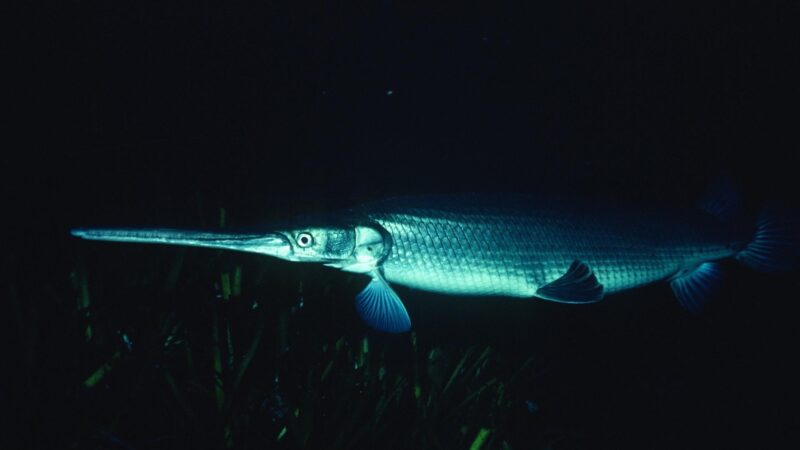
With a long and narrow snout that’s more than twice the length of its entire body, the longnose gar can survive in environments with low amounts of oxygen and higher salinity content compared to most fish. It thrashes its head to capture and subdue prey using its snout and crushes them with its numerous, prominent teeth.
- Scientific Name: Lepisosteus osseus
- Appearance: Torpedo-shaped bodies with extremely long snouts filled with sharp teeth, as well as thick armor-like scales.
- Color: Olive brown coloration with a white belly and dark spots on its median fins
- Lifespan: Up to 22 years (wild), up to 30 years (captivity)
- Habitat: Lowland habitats such as lakes, estuaries, reservoirs, sluggish areas found in large rivers, and brackish water environments.
- Height: 0.71 to 1.2 meters
- Weight: 1 to 3 kilograms
- Diet: Small crustaceans, insects, and fish
- Place Of Origin: Eastern United States
- Characteristics: Nocturnal, migratory, and relatively social as they spawn in congregations
8. Sawfish
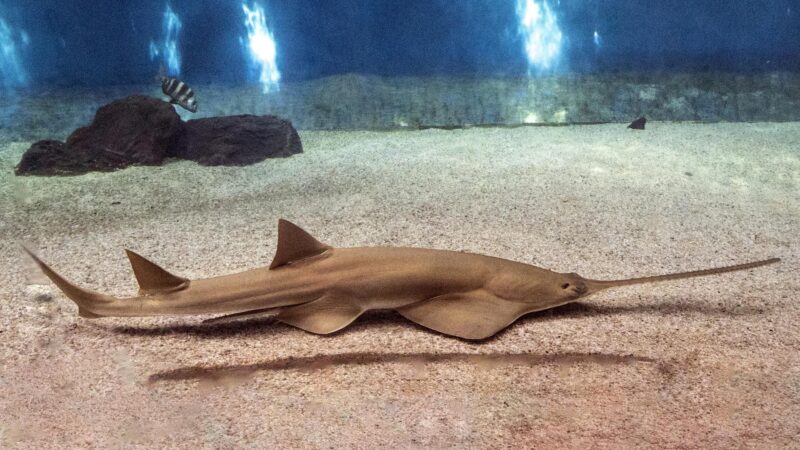
They are known for their distinctive elongated, saw-like snout or rostrum that have modified teeth-like scales. Sawfish are members of the ray family that use their rostrum for feeding as they thrash their heads in a side-to-side motion to stun, dislodge, and catch food, as well as for defense against their few known predators, which include crocodiles and sharks.
- Scientific Name: Pristidae
- Appearance: Flat-bodied fish with a flattened head and trunk, pectoral fins shaped like wings, and a distinctive long and flattened snout or “rostrum” that is studded with several teeth-like scales called denticles
- Color: Body coloration can range from gray to golden brown to green, with a cream-colored underbelly.
- Lifespan: Up to 35 years (wild), up to 42 years (captivity)
- Habitat: Preferably shallow waters with proximity to the coast, saltwater, tropical seas, lagoons, estuaries, creeks, river mouths, and even in rivers
- Height: 2.8 to 7.6 meters
- Weight: 315 to 600 kilograms
- Diet: Crustaceans (prawn, shrimp, and crab), a variety of fish, and mollusks
- Place Of Origin: Atlantic Ocean
- Characteristics: Nocturnal and poses no threat to humans unless provoked or disturbed in their habitats
9. Mandrill
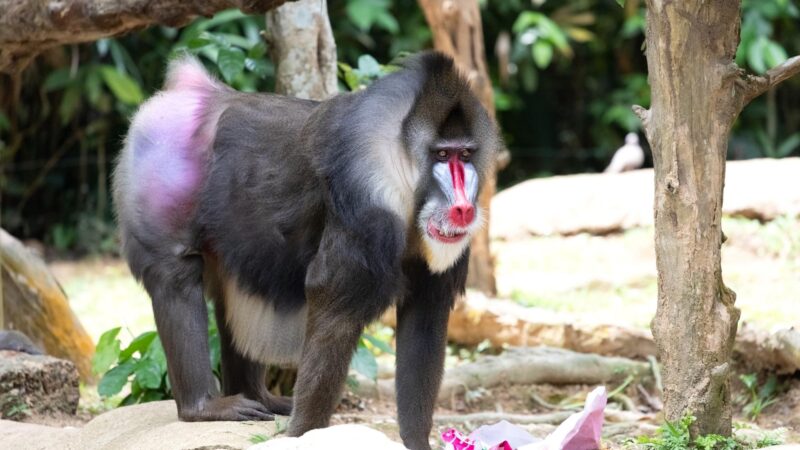
With a distinctive face that features an elongated snout with blue and purple ridges located on top as well as a red nose and lips, Mandrills are reclusive primates and are considered the largest monkeys in the world that can detect chemical signals related to social cues and mating through their highly sensitive sense of smell.
- Scientific Name: Mandrillus sphinx
- Appearance: Large, compact-bodied monkey with a hairless face, elongated snout, long limbs, stubby and upright tail, opposable thumbs, naked rump, and paired mammary glands.
- Color: Olive green pelage with pale underparts, a red stripe along the middle of its muzzle and around its nostrils, fur patches found above the eyes that are also red in color, blue and purple-ridged side muzzles, and a yellow beard. Coloration is duller in females compared to males.
- Lifespan: Up to 46 years (captivity)
- Habitat: Tropical forests (rainforests, montane forests, and thick secondary forests) and thick bush
- Height: 55 to 95 centimeters
- Weight: 11.5 to 25 kilograms
- Diet: Seeds, fruit, roots, fungi, insects, lizards, worms, snails, frogs, and occasionally, snakes and small vertebrates.
- Place Of Origin: Southwestern Cameroon, Southwestern Congo, Western Gabon, and Equatorial Guinea.
- Characteristics: Social monkeys as they can be found in groups consisting of up to 50 individuals. Diurnal, territorial, sedentary, and predominantly terrestrial but may also be arboreal.
10. Domestic Pig
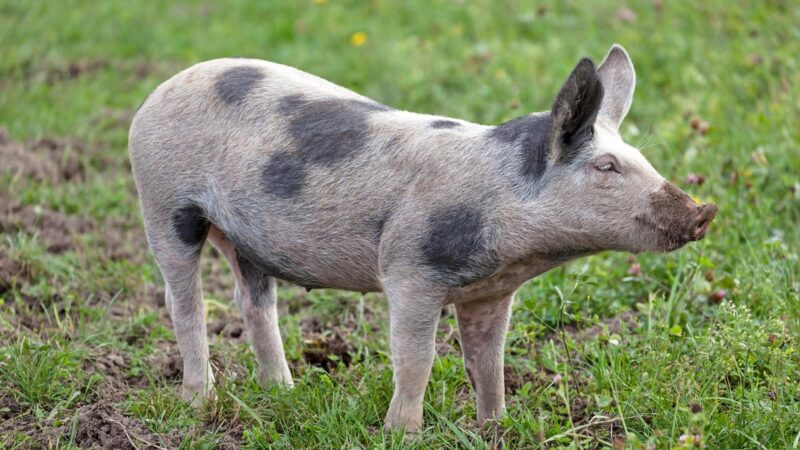
Domestic pig noses can be short or long and end in a cartilage disk that’s attached to muscles. Although they aren’t as sensitive as human noses, domestic pigs can use them for rooting into the soil to obtain iron to supplement their deficiencies, communication (both vocal and non-vocal), and cooling themselves by loosening soil and then burying their noses in them.
- Scientific Name: Sus scrofa scrofa
- Appearance: Stout-bodied animals with a flat back, sparse and short hair, short legs, thick skin, hooved feet with even toes, flat and elongated snouts, large ears, curly tails, and small eyes
- Color: Generally white overall coloration but can also be black, yellow, and pink.
- Lifespan: Up to 20 years (captivity)
- Habitat: Barns, large outdoor yards, pastures, farmlands, and agricultural lands. They prefer areas with a temperate climate.
- Height: 51 to 97 centimeters
- Weight: 50 to 350 kilograms
- Diet: Soy or barley, wheat, corn, grasses, nuts, and other plant material. Farm owners also feed them table scraps, bread, meat, fruit rinds, and vegetable peels, as well as formulated pig diets.
- Place Of Origin: Eurasia
- Characteristics: Diurnal, highly social, territorial, and sedentary
11. Tapir
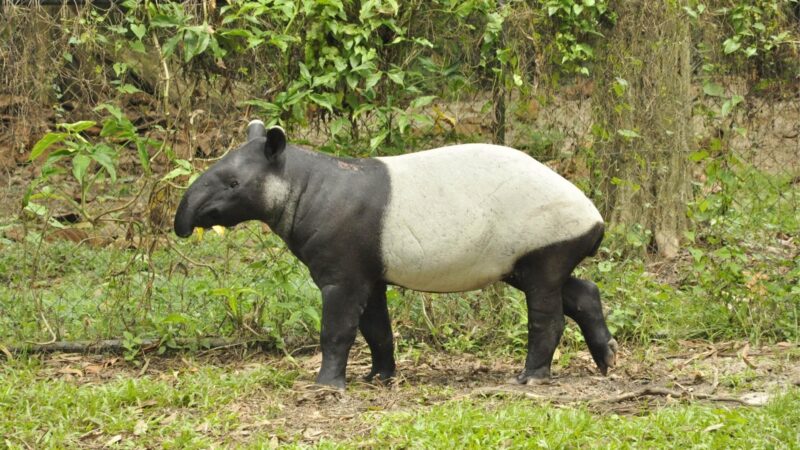
Tapirs have a prominent, elongated proboscis that is formed by their upper lip and extended snout. They use it for foraging, detecting stimuli, guiding their young, and smell.
As such, tapirs have an excellent sense of smell. They have often been mistaken for pigs due to their stout bodies, as well as anteaters due to their noses, but they are unrelated to both of them.
- Scientific Name: Tapiridae
- Appearance: Donkey-sized with a body that’s rounded on the rear and tapered at the front. They are bristly-haired and have short tails, short and slender legs, elongated noses, small eyes, and oval-shaped, erect ears.
- Color: All the South American tapir species have a gray or dark brown uniform coloration, while the Malayan tapir has a black front and hind legs and creamy white coloration through its midsection.
- Lifespan: Up to 30 years (wild)
- Habitat: Rainforests, mountain forests, and dry deciduous forests, but they also live in other habitats that are wooded or grassy.
- Height: 0.9 to 1.1 meters
- Weight: 136 to 300 kilograms
- Diet: Plant material such as twigs, leaves, buds, and fruits, particularly of low-growing plants, but they also feed on aquatic vegetation.
- Place Of Origin: South America, Cambodia, Myanmar, Malaya, Thailand, and Sumatra
- Characteristics: Solitary except for female adults that have offspring, reclusive, docile, easily frightened, crepuscular, and sedentary
12. Long-Nosed Bandicoot

Long-nosed bandicoots are sleek-looking marsupials that have sensitive, elongated noses used to forage for food. Once they locate a food item, they use their claws to create a conical hole, sniff out the bottom of it, then pinch the item out using their needle-like teeth. They are highly active animals that are often seen running or jumping up in the air.
- Scientific Name: Perameles nasuta
- Appearance: Long head, hunched posture, tapered tails, elongated snouts, small and pointed ears, 8 nipples, and a slightly cleft upper lip. Like all marsupials, they have pouches.
- Color: Sleek pelages that are reddish brown to sandy in color with white to cream underbellies.
- Lifespan: Up to 5.6 years (captivity)
- Habitat: Found in an extensive range of habitats such as in swamps, scrub brush, forests, and even in urban environments.
- Height: 45.7 to 50.8 centimeters
- Weight: 706 grams to 1.1 kilograms
- Diet: Insects such as beetles and their larvae, as well as other invertebrates such as caterpillars and spiders. They also feed on plants, fungi, and small vertebrates such as mice.
- Place Of Origin: East coast of Australia
- Characteristics: Nocturnal, solitary, sedentary, terrestrial, and territorial
13. Aardvark
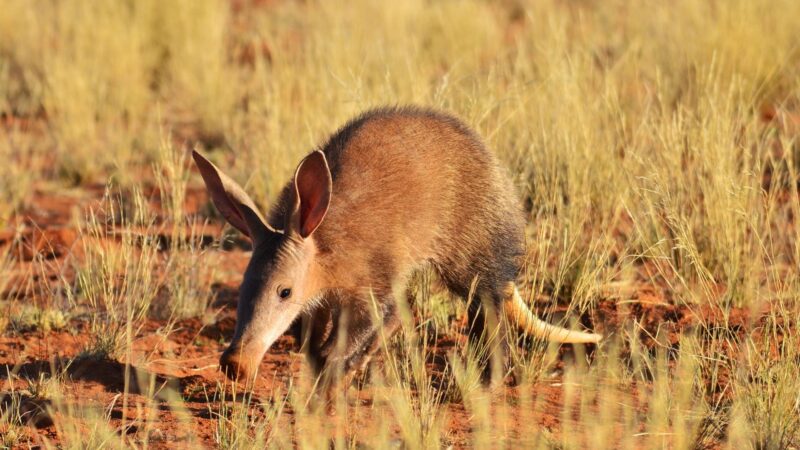
Aardvarks possess an exceptional sense of smell thanks to their long noses that can increase their turbinal surface areas, which consequently results in the improved reception of olfactory signals in their brains. Interestingly, their skulls have a swollen appearance in the middle due to their highly-developed olfactory region.
- Scientific Name: Orycteropus afer
- Appearance: Pig-sized animals with rounded bodies, thick skin with no fat layer, muscular limbs, small heads, spade-like claws, and a long nose, tongue, ears, and tail that has a tapered end.
- Color: Body color ranges from light brown to pinkish-gray with black legs and a pale-colored tail and face.
- Lifespan: Up to 18 years (wild), up to 23 years (captivity)
- Habitat: Savannas, grasslands, woodlands, agricultural lands, and montane and lowland forests where they dig burrows across landscapes.
- Height: 100 to 158 centimeters
- Weight: 40 to 82 kilograms
- Diet: They are considered myrmecophagous or animals that specialize in consuming termites and ants. They also feed on beetle pupae and larvae.
- Place Of Origin: Sub-saharan Africa
- Characteristics: Reclusive animals that are usually solitary except when they are with their young or when living in well-established burrows, as they can be found with 2 or 3 other individuals. They are nomadic, territorial, and nocturnal.
14. Proboscis Monkey

Also called long-nosed monkeys, these animals are endemic to the island of Borneo. Proboscis monkeys use their large, protruding noses to enhance their communication by resonating their vocalizations through a given area. They have specialized nasal cartilages that provide support for their large noses.
- Scientific Name: Nasalis larvatus
- Appearance: Large monkey with a big nose, long coat, bulging stomachs, and webbing between the digits of their feet.
- Color: Generally pink and brown fur, but it can be varying shades of brown, red, and orange, with red around the shoulders and head. They have gray legs, arms, and tails. Males have black scrotums and a red-colored penis.
- Lifespan: Up to 23 years (captivity)
- Habitat: Low-land habitats such as mangrove forests are found along estuaries and rivers, swamplands, and rainforests.
- Height: 61 to 76 centimeters
- Weight: 7 to 22 kilograms
- Diet: Mostly fruits, young leaves, seeds, and mangrove shoots, but they also feed on some invertebrates, such as caterpillars and their larvae.
- Place Of Origin: Borneo
- Characteristics: Primarily arboreal but can occasionally be terrestrial and move quadrupedally between trees. They are diurnal, social as they thrive in groups of up to 32 individuals, and sedentary.
15. Elephants
Elephants have large and long noses that are, on average, 6 feet in length. It contains 150,000 muscle units and tendons that allow the animals to move with precision and strength. They use their trunks for water intake, sensory functions (smell and touch), feeding, communication and sound production, offense and defense, and lifting.
- Scientific Name: Elephantidae
- Appearance: African Savanna elephants have low-domed heads and saddle-shaped backs, while Asian elephants have double-domed heads and humped-shaped backs. Both have large ears and upward-curving ivory tusks, but the Asian elephant is both smaller in size.
- Color: Varying shades of gray but some parts of their skin may lack in color, especially on the forehead, trunk, and ears.
- Lifespan: Up to 70 years (wild), up to 80 years (captivity)
- Habitat: African elephants inhabit rainforests, savannas, scrub forests, and woodlands, while Asian elephants live in grasslands and forests found in tropical regions.
- Height: 2.4 to 4 meters
- Weight: 2,000 to 6,100 kilograms
- Diet: Plant material such as herbs, tree foliage and bark, wood, fruits, grasses, grains, seeds, and flowers. Common diet items include legumes, spurges, sedges, mallows, basswoods, and buckthorns.
- Place Of Origin: Africa and Asia
- Characteristics: Slow-moving animals that are crepuscular, social as they live in herds of up to 70 members, nomadic, and not territorial.
What Animal Has the Largest Nose?
Elephants have the largest noses among all living animals, with a length of 1.8 to 2.4 meters and a nostril diameter of 5.1 centimeters.
What Animal Has Four Noses?
Slugs have four “noses” which are two pairs of retractable tentacles. The upper first pair are the optical tentacles with black, light-sensitive eyespots on the end used for sight, while the lower second pair are tentacles used for tasting, feeling, and smelling.
Animal noses that are elongated are referred to as proboscis, which differs from a snout and rostrum. They are usually used for foraging and feeding but also serve other purposes such as mating, detecting environmental stimuli, providing the animal with an excellent sense of smell, and other physical actions such as nudging and guiding their young.
List of Sources
Flynn, P. (2012). Zaglossus bartoni. Animal Diversity Web.
Kurnit, J. (2009). “Diceros bicornis. Animal Diversity Web.
Braddy, S. (2003). Nasua nasua. Animal Diversity Web.
Carter, N. (2006). Potamochoerus larvatus. Animal Diversity Web.
Warburton, K. (2002). Mirounga angustirostris. Animal Diversity Web.
